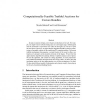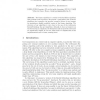APPROX
2004
Springer
15 years 19 days ago
2004
Springer
In this paper we investigate the computational complexity of a combinatorial problem that arises in the reverse engineering of protein and gene networks. Our contributions are as ...
APPROX
2004
Springer
15 years 19 days ago
2004
Springer
We study the problem of minimizing the broadcast time for a set of processors in a cluster, where processor has transmission time , which is the time taken to send a message to any...
APPROX
2004
Springer
15 years 19 days ago
2004
Springer
In many economic settings, convex figures on the plane are for sale. For example, one might want to sell advertising space on a newspaper page. Selfish agents must be motivated ...
APPROX
2004
Springer
15 years 19 days ago
2004
Springer
ABSTRACT: Let G(n, c/n) and Gr(n) be an n-node sparse random graph and a sparse random rregular graph, respectively, and let I(n, r) and I(n, c) be the sizes of the largest indepen...
APPROX
2004
Springer
15 years 19 days ago
2004
Springer
We consider the problem of Simultaneous Source Location – selecting locations for sources in a capacitated graph such that a given set of demands can be satisfied. We give an ex...
APPROX
2004
Springer
15 years 19 days ago
2004
Springer
A quantum encryption scheme (also called private quantum channel, or state randomization protocol) is a one-time pad for quantum messages. If two parties share a classical random s...
APPROX
2004
Springer
15 years 19 days ago
2004
Springer
Consider the following communication problem, that leads to a new notion of edge coloring. The communication network is represented by a bipartite multigraph, where the nodes on o...
APPROX
2004
Springer
15 years 19 days ago
2004
Springer
In standard property testing, the task is to distinguish between objects that have a property P and those that are ε-far from P, for some ε > 0. In this setting, it is perfec...
APPROX
2004
Springer
15 years 19 days ago
2004
Springer
Given any integer d ≥ 3, let k be the smallest integer such that d < 2k log k. We prove that with high probability the chromatic number of a random d-regular graph is k, k + 1...
ANTS
2004
Springer
15 years 19 days ago
2004
Springer
The binary algorithm is a variant of the Euclidean algorithm that performs well in practice. We present a quasi-linear time recursive algorithm that computes the greatest common di...


